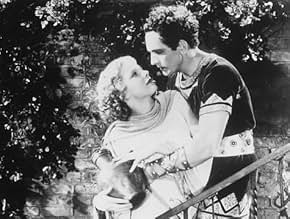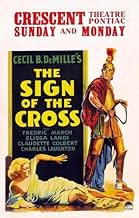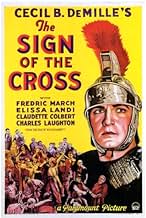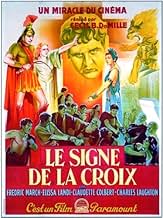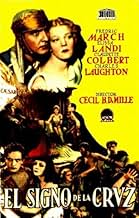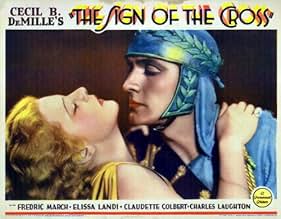CALIFICACIÓN DE IMDb
6.8/10
2.9 k
TU CALIFICACIÓN
Un soldado romano se debate entre su amor por una mujer cristiana y su lealtad al emperador Nerón.Un soldado romano se debate entre su amor por una mujer cristiana y su lealtad al emperador Nerón.Un soldado romano se debate entre su amor por una mujer cristiana y su lealtad al emperador Nerón.
- Dirección
- Guionistas
- Elenco
- Nominado a 1 premio Óscar
- 3 premios ganados y 1 nominación en total
Joyzelle Joyner
- Ancaria
- (as Joyzelle)
Robert Seiter
- Philodemus
- (as Robert Manning)
Opiniones destacadas
Rome - First Century A. D. Nero, the mad Emperor & Poppaea, his vile Empress, engage in every sort of vice & degradation. Wanton cruelty becomes a spectator sport and virtue & innocence are denigrated. Slowly, however, a new Power is growing. People calling themselves Christians are secretly spreading their Faith ever more widely. They are horribly persecuted, but they continue to multiply. Which will eventually triumph - the might of Imperial Rome, or the gentle ones who follow THE SIGN OF THE CROSS?
This Cecil B. DeMille epic is a vivid retelling of the struggles of the first Christians. Paramount gave the film a lavish production and DeMille wrings every drop of piety & puerile interest possible from the plot. Fredric March is stalwart as the Roman official who falls in love with a beautiful Christian girl. While his ultimate conversion wouldn't convince the average modern Baptist, he holds his own in scenes with other performers whom are allowed to behave outrageously. Elissa Landi is sweet as the virtuous Believer, effectively underplaying her role.
`Do you want to play the most wicked woman in the world?' DeMille asked Claudette Colbert one day on the studio lot. She did & she does memorably, from her eye-popping milk bath scene to her revenge on her would-be lover. Sniveling, whining and wearing a huge fake nose, Charles Laughton is pure effeminate evil as Nero (notice his catamite), a foul blot on the face of humanity & stealing all his scenes from everyone else. History tells us that Nero eventually murdered Poppaea by stomping her to death...
Ian Keith is enjoyable as an unpunished villain. Ferdinand Gottshalk & Vivian Tobin are effectively degraded as Roman bacchants. Film mavens will recognize the voice of John Carradine, calling `We who are about to die, salute you!' out of the arena to Nero; he can later be spotted in the role of a Christian martyr ascending the dungeon stairs to his death.
DeMille had just returned to Paramount from a 3-year, 3-picture stint at MGM, where he was remarkably subdued. Back at his home studio he was allowed more license. Wrapping a little sermon up in a lot of sin, he filled this pre-Production Code drama with plenty of the latter. When THE SIGN OF THE CROSS was re-released in 1944, many cuts had to be made. The film now having been restored, it's not difficult to guess which sections those were. The Dance of the Naked Moon & much of the antics in the final arena sequence are beyond the bounds of good taste, but certainly not beyond the bounds of Cecil B. DeMille.
This Cecil B. DeMille epic is a vivid retelling of the struggles of the first Christians. Paramount gave the film a lavish production and DeMille wrings every drop of piety & puerile interest possible from the plot. Fredric March is stalwart as the Roman official who falls in love with a beautiful Christian girl. While his ultimate conversion wouldn't convince the average modern Baptist, he holds his own in scenes with other performers whom are allowed to behave outrageously. Elissa Landi is sweet as the virtuous Believer, effectively underplaying her role.
`Do you want to play the most wicked woman in the world?' DeMille asked Claudette Colbert one day on the studio lot. She did & she does memorably, from her eye-popping milk bath scene to her revenge on her would-be lover. Sniveling, whining and wearing a huge fake nose, Charles Laughton is pure effeminate evil as Nero (notice his catamite), a foul blot on the face of humanity & stealing all his scenes from everyone else. History tells us that Nero eventually murdered Poppaea by stomping her to death...
Ian Keith is enjoyable as an unpunished villain. Ferdinand Gottshalk & Vivian Tobin are effectively degraded as Roman bacchants. Film mavens will recognize the voice of John Carradine, calling `We who are about to die, salute you!' out of the arena to Nero; he can later be spotted in the role of a Christian martyr ascending the dungeon stairs to his death.
DeMille had just returned to Paramount from a 3-year, 3-picture stint at MGM, where he was remarkably subdued. Back at his home studio he was allowed more license. Wrapping a little sermon up in a lot of sin, he filled this pre-Production Code drama with plenty of the latter. When THE SIGN OF THE CROSS was re-released in 1944, many cuts had to be made. The film now having been restored, it's not difficult to guess which sections those were. The Dance of the Naked Moon & much of the antics in the final arena sequence are beyond the bounds of good taste, but certainly not beyond the bounds of Cecil B. DeMille.
1932 – the height of the depression, Paramount studios in financial straits, Hollywood's output limited to small-scale dramas and bedroom comedies – and Cecil B. DeMille decides to make an epic. There are many classics among the "small" pictures of the early-30s, but it's good to see that someone was, against all odds, still carrying the torch for grandeur and spectacle.
Of course, Sign of the Cross is still an epic of its poverty-stricken time. There are no stupendous sets or masses of extras, but DeMille always knew how to make our eyes deceive us. A huddle of a dozen people filling the screen looks like a crowd. Five men on horseback shot from a low angle looks like a stampede. In the scene where Titus and Favius first meet, the camera wheels round and backs away at the same time, giving the impression that the street scene is much more than a cramped indoor set. And DeMille's use of lighting (here courtesy of Karl Struss who was Oscar-nominated for his efforts) really pays off, with fuzzy half-light and shadows disguising the lack of lavishness.
Better yet, the constrained budget seems to have pushed DeMille to concentrating more on the poetry and beauty of what we see. Unable to dazzle us with scale or special effects, he makes full use of his talent for flowing, dreamlike imagery. Sign of the Cross features some of the smoothest camera-work and carefully choreographed movement of extras of this period. He even makes effective use of slow-motion with the pouring goats milk. DeMille was not the only director to turn to simple camera trickery when money was tight – Rouben Mamoulian's earliest pictures for example are end-to-end cheap tricks. It's just that DeMille is doing it better than almost everyone else – it adds sparkle to the picture without being distracting.
But it's not just with the images that DeMille shows his talent. Unlike some directors who were sceptical about the coming of sound and tried to work around it, or some producers who naively thought it automatically made pictures twice as good, DeMille really explores the possibilities of sound. In an early scene, we cut to a close-up Elissa Landi while we hear from off-screen the calls of Romans searching for Christians. We see her reaction to the calls, and this is something that could not be achieved so succinctly in a silent movie. A more obvious example is the torture scene, where we hear the boy's screams, while the camera is pointed elsewhere. The point is, we do not need to see him being tortured because the scream alone has enough impact. However what we do see – the eagle of Rome, a sentry unconcernedly marching back and forth, a flaming torch – adds layers of meaning to the scene.
Of course, this being DeMille, and it being the "pre-code" era, he also seeks to dazzle us with a bit of bare flesh and other assorted depravities. It's one of the great ironies of DeMille's work that his pictures often revel in the very "immorality" they seek to preach against. So the poster advertising the attractions at the Colloseum is as much to whet the appetite of the real-world audience as to show the barbaric tastes of the Roman one. DeMille spends ten minutes of screen time (not to mention more precious money on tin-hat manufacture and zoo rental fees) on the promised blood-fest, which can only be for our entertainment since it is inconsequential to the plot. And, in another bit of audio/visual juxtaposition, while the martyrs' chanting drowns out the "Naked Moon" song, it is the notorious Lesbian dance that DeMille shows us, not the Christians outside.
The acting in Sign of the Cross is a bit of a mixed bag, although it is of a higher standard than many of the DeMille talkies. Charles Laughton is hammily brilliant, laying down a blueprint for Emperor Nero which Peter Ustinov would follow to a well-deserved Oscar-nomination in Quo Vadis (1951). However Laughton's part is fairly small, and the screenplay makes Claudette Colbert the real villain. Colbert is fantastic, playing the Empress as an ancient world vamp, giving by far the best performance of the bunch. It's almost a shame that It Happened One Night re-invented her as a major romantic lead, because she really was at her best when she played villains.
The weakest link in Sign of the Cross, as with many DeMille pictures, is the screenplay. However DeMille's inventiveness, careful construction and strong imagery, not to mention the fact that his pictures are great fun if you don't take them too seriously, transcend the limpness of the script. It was perhaps because DeMille refused to allow his style to be compromised by a limited budget that makes many of his 1930s pictures among his greatest.
Of course, Sign of the Cross is still an epic of its poverty-stricken time. There are no stupendous sets or masses of extras, but DeMille always knew how to make our eyes deceive us. A huddle of a dozen people filling the screen looks like a crowd. Five men on horseback shot from a low angle looks like a stampede. In the scene where Titus and Favius first meet, the camera wheels round and backs away at the same time, giving the impression that the street scene is much more than a cramped indoor set. And DeMille's use of lighting (here courtesy of Karl Struss who was Oscar-nominated for his efforts) really pays off, with fuzzy half-light and shadows disguising the lack of lavishness.
Better yet, the constrained budget seems to have pushed DeMille to concentrating more on the poetry and beauty of what we see. Unable to dazzle us with scale or special effects, he makes full use of his talent for flowing, dreamlike imagery. Sign of the Cross features some of the smoothest camera-work and carefully choreographed movement of extras of this period. He even makes effective use of slow-motion with the pouring goats milk. DeMille was not the only director to turn to simple camera trickery when money was tight – Rouben Mamoulian's earliest pictures for example are end-to-end cheap tricks. It's just that DeMille is doing it better than almost everyone else – it adds sparkle to the picture without being distracting.
But it's not just with the images that DeMille shows his talent. Unlike some directors who were sceptical about the coming of sound and tried to work around it, or some producers who naively thought it automatically made pictures twice as good, DeMille really explores the possibilities of sound. In an early scene, we cut to a close-up Elissa Landi while we hear from off-screen the calls of Romans searching for Christians. We see her reaction to the calls, and this is something that could not be achieved so succinctly in a silent movie. A more obvious example is the torture scene, where we hear the boy's screams, while the camera is pointed elsewhere. The point is, we do not need to see him being tortured because the scream alone has enough impact. However what we do see – the eagle of Rome, a sentry unconcernedly marching back and forth, a flaming torch – adds layers of meaning to the scene.
Of course, this being DeMille, and it being the "pre-code" era, he also seeks to dazzle us with a bit of bare flesh and other assorted depravities. It's one of the great ironies of DeMille's work that his pictures often revel in the very "immorality" they seek to preach against. So the poster advertising the attractions at the Colloseum is as much to whet the appetite of the real-world audience as to show the barbaric tastes of the Roman one. DeMille spends ten minutes of screen time (not to mention more precious money on tin-hat manufacture and zoo rental fees) on the promised blood-fest, which can only be for our entertainment since it is inconsequential to the plot. And, in another bit of audio/visual juxtaposition, while the martyrs' chanting drowns out the "Naked Moon" song, it is the notorious Lesbian dance that DeMille shows us, not the Christians outside.
The acting in Sign of the Cross is a bit of a mixed bag, although it is of a higher standard than many of the DeMille talkies. Charles Laughton is hammily brilliant, laying down a blueprint for Emperor Nero which Peter Ustinov would follow to a well-deserved Oscar-nomination in Quo Vadis (1951). However Laughton's part is fairly small, and the screenplay makes Claudette Colbert the real villain. Colbert is fantastic, playing the Empress as an ancient world vamp, giving by far the best performance of the bunch. It's almost a shame that It Happened One Night re-invented her as a major romantic lead, because she really was at her best when she played villains.
The weakest link in Sign of the Cross, as with many DeMille pictures, is the screenplay. However DeMille's inventiveness, careful construction and strong imagery, not to mention the fact that his pictures are great fun if you don't take them too seriously, transcend the limpness of the script. It was perhaps because DeMille refused to allow his style to be compromised by a limited budget that makes many of his 1930s pictures among his greatest.
THE SIGN OF THE CROSS (Paramount, 1932), directed by Cecil B. DeMille, returns its director to the genre to what he's best known, the religious spectacle, his first since THE KING OF KINGS (Pathe, 1927) starring H.B. Warner as Jesus the Christ. While this title certainly indicates another retelling into the life of Christ, the script, taken from an old play by Wilson Barrett, focuses more on Christians following in the teachings of Jesus years after His crucifixion, only to face suffering and prosecution for their faith.
The setting is 64 A.D. where the Emperor Nero (Charles Laughton) is introduced playing his lyre while watching in laughter the flames raging through the city of Rome. Although responsible for starting the fire, Nero places the blame on the Christians, arranging for his guards to have them placed under arrest. His wife, Poppara (Claudette Colbert), is an adulteress whose only desire is the manly Marcus Superbus (Fredric March), a prefect of Rome, but cannot put her hold on him after learning from Dacia (Vivian Tobin) of his love for Mercia (Elissa Landi), a Christian girl. As much as Marcus believes "Christianity is stupid," he tries his best to persuade Mercia to renounce her faith and marry him. Tigellinus (Ian Keith), Marcus' rival, sees an opportunity in making trouble for them both.
With crime dramas, drawing room comedies and/or social related issues as common theme during the Depression era, THE SIGN OF THE CROSS was something out of the ordinary. In true DeMille fashion, THE SIGN OF THE CROSS is not only a 128 minute spectacle with a three minute intermission in the midway point, but a large-scale production with lavish sets and cast of thousands accurately costumed according to its time structure. Of the performers in this Biblical story, Elissa Landi, the central character, seems out of place with her 1932 head-dress while Claudette Colbert, in her first "bad girl" role, quite evident with her lipstick and pencil drawn eyelashes, has her cherished moment bathing in a pool of milk gulped along side by two kittens at a distance. Fredric March as the Roman soldier who rules with the cracking of his whip, physically makes a convincing Marcus, though some of his badly scripted dialog, along with others in the cast, may provoke laughter for any contemporary viewer. Charles Laughton's Nero is exceptional, right down to his curly hair with added putty in the middle of his nose adding sharpness to his cruel facial expression. Although his scenes are regrettably limited, Laughton simply stands out, especially as he watches in sleepy-eyed boredom the slaughter of victims at the arena as he sits back eating large portions of food. Other members in the large cast include Tommy Conlan as Stephanus, the teenage Christian boy; Nat Pendleton, Arthur Hohl, Charles Middleton; lions, tigers, crocodiles and elephants as uncredited extras.
As much as the plot was reworked into the MGM spectacle of QUO VADIS (1951) starring Robert Taylor as Marcus; with Deborah Kerr and Peter Ustinov giving a tour-da-force performance as Nero, nothing can compare with the intense arena sequence found in THE SIGN OF THE CROSS. Graphic, then and now, this sequence, along with "The Naked Moon" dance performed by the wicked Ancaria (Joyzelle Joyner), was all that was missing when THE SIGN OF THE CROSS was not only reissued to theaters in 1944, but when sold to commercial television around the 1960s. In its place was a ten minute prologue written by Dudley Nichols, set during World War II with the cast featuring Stanley Ridges (Chaplain Thomas Lloyd); Arthur Shields (Captain James Costello); James Millican (Captain Kevin Driscoll); William Forrest (Colonel Hugh Mason); Tom Tully (Hoboken); Oliver Thorndyke (Lieutenant Roger Hammond); and Joel Allen. The new opening revolves around bombardiers being assigned on a dangerous mission and heading out to their destination. As the airplane flies over the Colosseum, a discussion about to the prosecution of Christians under Nero's regime leads to a flashback and events that takes place.
It wasn't until March 14, 1993, when American Movie Classics cable channel presented the original uncut 1932 theatrical release of THE SIGN OF THE CROSS that was obtained from the DeMille estate, and played it as part of AMC's initial Film Preservation Society festival. Without these missing scenes, THE SIGN OF THE CROSS would have been hopelessly dull and talkie, such as the case with the 1944 reissue that had circulated for nearly half a century. In 1995, Universal Home Video distributed the now uncensored 1932 version to home video and then to DVD in 2006. After AMC ceased airing THE SIGN OF THE CROSS in 1999, Turner Classic Movies picked up its option by airing this DeMille epic where it played from occasionally from 2004 to 2007. Regardless of its flaws, THE SIGN OF THE CROSS is prime DeMille, best suited for viewing during the season of Lent or Good Friday. Hail Caesar!! (***1/2)
The setting is 64 A.D. where the Emperor Nero (Charles Laughton) is introduced playing his lyre while watching in laughter the flames raging through the city of Rome. Although responsible for starting the fire, Nero places the blame on the Christians, arranging for his guards to have them placed under arrest. His wife, Poppara (Claudette Colbert), is an adulteress whose only desire is the manly Marcus Superbus (Fredric March), a prefect of Rome, but cannot put her hold on him after learning from Dacia (Vivian Tobin) of his love for Mercia (Elissa Landi), a Christian girl. As much as Marcus believes "Christianity is stupid," he tries his best to persuade Mercia to renounce her faith and marry him. Tigellinus (Ian Keith), Marcus' rival, sees an opportunity in making trouble for them both.
With crime dramas, drawing room comedies and/or social related issues as common theme during the Depression era, THE SIGN OF THE CROSS was something out of the ordinary. In true DeMille fashion, THE SIGN OF THE CROSS is not only a 128 minute spectacle with a three minute intermission in the midway point, but a large-scale production with lavish sets and cast of thousands accurately costumed according to its time structure. Of the performers in this Biblical story, Elissa Landi, the central character, seems out of place with her 1932 head-dress while Claudette Colbert, in her first "bad girl" role, quite evident with her lipstick and pencil drawn eyelashes, has her cherished moment bathing in a pool of milk gulped along side by two kittens at a distance. Fredric March as the Roman soldier who rules with the cracking of his whip, physically makes a convincing Marcus, though some of his badly scripted dialog, along with others in the cast, may provoke laughter for any contemporary viewer. Charles Laughton's Nero is exceptional, right down to his curly hair with added putty in the middle of his nose adding sharpness to his cruel facial expression. Although his scenes are regrettably limited, Laughton simply stands out, especially as he watches in sleepy-eyed boredom the slaughter of victims at the arena as he sits back eating large portions of food. Other members in the large cast include Tommy Conlan as Stephanus, the teenage Christian boy; Nat Pendleton, Arthur Hohl, Charles Middleton; lions, tigers, crocodiles and elephants as uncredited extras.
As much as the plot was reworked into the MGM spectacle of QUO VADIS (1951) starring Robert Taylor as Marcus; with Deborah Kerr and Peter Ustinov giving a tour-da-force performance as Nero, nothing can compare with the intense arena sequence found in THE SIGN OF THE CROSS. Graphic, then and now, this sequence, along with "The Naked Moon" dance performed by the wicked Ancaria (Joyzelle Joyner), was all that was missing when THE SIGN OF THE CROSS was not only reissued to theaters in 1944, but when sold to commercial television around the 1960s. In its place was a ten minute prologue written by Dudley Nichols, set during World War II with the cast featuring Stanley Ridges (Chaplain Thomas Lloyd); Arthur Shields (Captain James Costello); James Millican (Captain Kevin Driscoll); William Forrest (Colonel Hugh Mason); Tom Tully (Hoboken); Oliver Thorndyke (Lieutenant Roger Hammond); and Joel Allen. The new opening revolves around bombardiers being assigned on a dangerous mission and heading out to their destination. As the airplane flies over the Colosseum, a discussion about to the prosecution of Christians under Nero's regime leads to a flashback and events that takes place.
It wasn't until March 14, 1993, when American Movie Classics cable channel presented the original uncut 1932 theatrical release of THE SIGN OF THE CROSS that was obtained from the DeMille estate, and played it as part of AMC's initial Film Preservation Society festival. Without these missing scenes, THE SIGN OF THE CROSS would have been hopelessly dull and talkie, such as the case with the 1944 reissue that had circulated for nearly half a century. In 1995, Universal Home Video distributed the now uncensored 1932 version to home video and then to DVD in 2006. After AMC ceased airing THE SIGN OF THE CROSS in 1999, Turner Classic Movies picked up its option by airing this DeMille epic where it played from occasionally from 2004 to 2007. Regardless of its flaws, THE SIGN OF THE CROSS is prime DeMille, best suited for viewing during the season of Lent or Good Friday. Hail Caesar!! (***1/2)
Cecil B. DeMille was famous for the excesses he depicted on screen, and "The Sign of the Cross" has enough excess for a dozen movies by any other director. Fortunately, DeMille loved to detail the debauchery that warranted divine punishment, because he was more adept and entertaining when portraying orgies than he was when depicting piety. Perhaps sin is intrinsically more interesting than virtue. Certainly the sinful characters, especially Charles Laughton as Nero and Claudette Colbert as Poppaea, are riveting and colorfully conceived. Laughton lolls around on his divans, while alluring slave boys attend to his whims. Colbert lures and tempts lovers when not catering to her bare flesh in a milk bath. Bloody gladiatorial games and the obligatory feeding Christians to the wild beasts keep the proceedings on track, and an erotic Lesbian dance enlivens an otherwise dragging orgiastic gathering. Orgies can be difficult to film because the delights are far more evident to participants than they are to viewers. Perhaps every orgy needs a Lesbian dance.
Unfortunately, DeMille felt compelled to throw away screen time on a group of early Christians, whose idea of a good time was to sit on rocks, sing tuneless songs, and listen to a motivational speaker. Naturally, the improbably named Marcus Superbus, played by Frederic March in a fetching mini-skirt and tight curls, falls in love with Mercia, a bland, but virginal, Elissa Landi, and he rejects the advances of the milky, silky Claudette Colbert, who had been around the Colosseum a few times. Of course, March not only rejects Colbert, but risks losing the endless parties and his own rising career for the touch of Landi's soft hand. "The Sign of the Cross" is hardly convincing drama despite the lure of Romans sinning every way, everywhere, and with everybody.
If the corny dialog and stilted scenes of pious proceedings had been severely cut and Laughton's and Colbert's roles had been brought to center focus, the film would have been a delicious camp spectacle. However, as the film now plays, viewers must patiently wait out the dull-as-drying-paint scenes with Landi and company to savor the sinful delights of Nero and Poppaea, which make "The Sign of the Cross" worth a look and a hoot or two.
Unfortunately, DeMille felt compelled to throw away screen time on a group of early Christians, whose idea of a good time was to sit on rocks, sing tuneless songs, and listen to a motivational speaker. Naturally, the improbably named Marcus Superbus, played by Frederic March in a fetching mini-skirt and tight curls, falls in love with Mercia, a bland, but virginal, Elissa Landi, and he rejects the advances of the milky, silky Claudette Colbert, who had been around the Colosseum a few times. Of course, March not only rejects Colbert, but risks losing the endless parties and his own rising career for the touch of Landi's soft hand. "The Sign of the Cross" is hardly convincing drama despite the lure of Romans sinning every way, everywhere, and with everybody.
If the corny dialog and stilted scenes of pious proceedings had been severely cut and Laughton's and Colbert's roles had been brought to center focus, the film would have been a delicious camp spectacle. However, as the film now plays, viewers must patiently wait out the dull-as-drying-paint scenes with Landi and company to savor the sinful delights of Nero and Poppaea, which make "The Sign of the Cross" worth a look and a hoot or two.
My favorite DeMille film. Charles Laughton and Claudette Colbert are delicious as the debauched emperor and empress of Rome. Prominent supporting players Arthur Hohl and Harry Beresford appeared in two horror classics (ISLAND OF LOST SOULS and DOCTOR X, respectively) the very same year. John Carradine can be seen as a condemned Christian on his way to the arena (you can also hear his voice as a spectator and as a gladiator). Very sharp viewers can also spot Dave O'Brien (a condemned Christian) and Kent Taylor (a disinterested spectator). Three famous scenes still impress today: Poppaea's milk bath; Ancaria's attempted lesbian seduction of Mercia; the outrageous arena sequence featuring beheadings, burnings, impalements, hungry crocodiles, untamed apes, bears, tigers and, of course, lions. Only C.B. could have gotten away with this in 1932! The closing cast list includes the characters Viturius, Servillius and Philodemus, but I'm not sure who they are. Viturius may have been Marcus' soldier-aide, although he doesn't look as burly as Richard Alexander. The other two must be Strabo's ugly, brutish companion and the old Christian man protective of the little orphan girl.
¿Sabías que…?
- TriviaCecil B. DeMille was pressured to drop Ancaria's seductive dance in the orgy scene by Will H. Hays of the Hays Office, but DeMille adamantly refused. Still, censors often cut out gruesome parts of the film, particularly, the cart carrying dead bodies out of the arena, a gorilla dancing around a semi-nude girl, elephants stomping Christians and picking them up with their tusks, crocodiles about to eat a bound girl, etc. These scenes are all in the restored version.
- ErroresWe see a woman tied up in the Coliseum as crocodiles are set loose on her. They are clearly alligators (broad snout), which were unknown to Europeans until Columbus's time, 15 centuries later. Only two countries have alligators: The United States and China.The Romans never went to either place.
- Versiones alternativasRe-released in 1944, with some cuts (sex and sadism scenes) and preceded by a nine minute prologue, set in present time with a WWII theme. This re-release version runs 118 minutes.
- ConexionesEdited into Through the Centuries (1933)
- Bandas sonorasChristian Hymn No.1
(1932) (uncredited)
Music and Lyrics by Rudolph G. Kopp
Sung a cappella by Christians at the meeting
Reprised by them after their capture and at the arena
Sung a cappella by Elissa Landi and Tommy Conlon
Played and sung offscreen at the end
Selecciones populares
Inicia sesión para calificar y agrega a la lista de videos para obtener recomendaciones personalizadas
- How long is The Sign of the Cross?Con tecnología de Alexa
Detalles
Taquilla
- Total en EE. UU. y Canadá
- USD 5,971,004
- Tiempo de ejecución2 horas 5 minutos
- Color
- Relación de aspecto
- 1.37 : 1
Contribuir a esta página
Sugiere una edición o agrega el contenido que falta

Principales brechas de datos
What is the French language plot outline for The Sign of the Cross (1932)?
Responda
